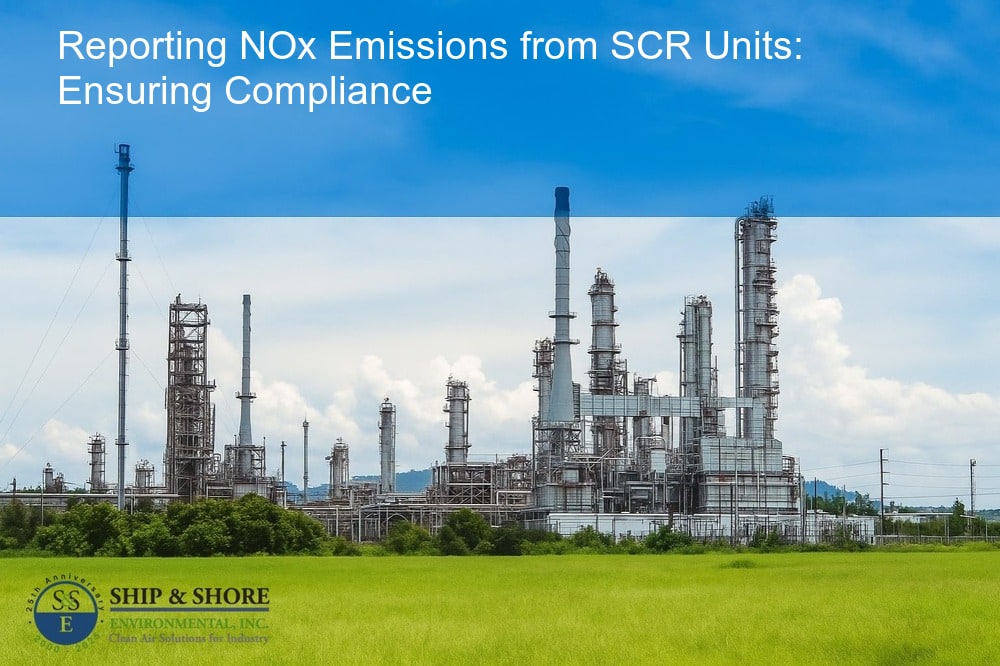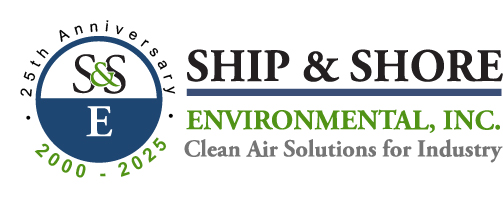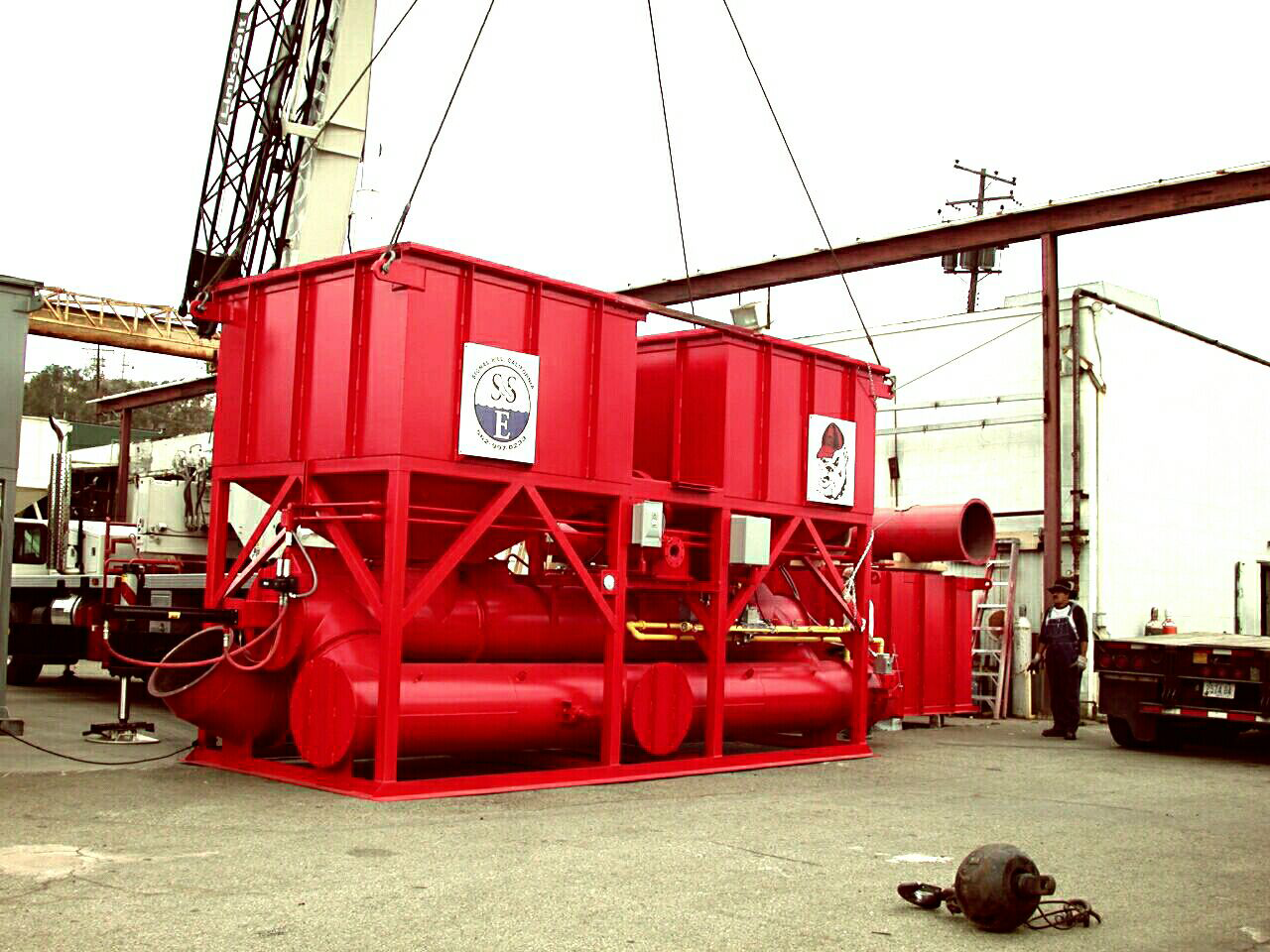
Accurate Reporting NOx Emissions from SCR Units Guide
October 1, 2025 6:03 amUnderstanding the Importance of Limiting NOx Emissions
In today’s world, reporting NOx emissions from SCR units is more critical than ever for ensuring environmental protection and regulatory compliance. Nitrogen oxides (NOx) are significant air pollutants that contribute to smog, acid rain, and respiratory problems. Limiting NOx emissions is essential for maintaining air quality and safeguarding public health. As industry leaders, we at Ship & Shore Environmental, Inc. understand the profound impact of these emissions and the pivotal role selective catalytic reduction (SCR) units play in minimizing them.
Overview of SCR (Selective Catalytic Reduction) Units
Selective Catalytic Reduction (SCR) is one of the most effective and widely used methods for controlling NOx emissions. This technology involves injecting a reductant, typically ammonia or urea, into the exhaust stream of a combustion process. The exhaust then passes over a catalyst, converting NOx into harmless nitrogen (N2) and water vapor (H2O). SCR units are employed across various industries, including power generation, manufacturing, and transportation, to comply with stringent emission standards.
The effectiveness of SCR units significantly depends on proper operation and maintenance, as well as accurate emissions measurement and reporting. The catalytic process must be carefully managed to ensure the optimal reduction of NOx emissions while avoiding excess ammonia slip. This careful balance underscores the importance of precise control and monitoring of SCR units.
The Need for Accurate Reporting of NOx Emissions from SCR Units
Accurate reporting of NOx emissions is not just a regulatory requirement but a cornerstone of our commitment to environmental stewardship. Regulatory agencies require detailed and accurate emissions data to evaluate environmental impact and enforce compliance. Discrepancies in reporting can lead to significant consequences, including fines, legal actions, and damage to a company’s reputation.
Effective reporting involves utilizing advanced monitoring techniques and technologies to provide real-time data on NOx emissions. Tools such as Continuous Emissions Monitoring Systems (CEMS) play a critical role in capturing and analyzing emissions data. Compliance with reporting standards ensures that we meet the legal requirements and demonstrates our dedication to transparency and environmental responsibility.
Basics of Reporting: What Does “Reporting NOx Emissions from SCR Units” Entail?
Reporting NOx emissions from SCR units is a critical aspect of environmental compliance. It entails capturing precise data about the amounts of nitrogen oxides (NOx) released into the atmosphere. This data must then be accurately documented and communicated to regulatory bodies, ensuring adherence to established environmental standards and regulations. Accurate reporting not only helps maintain compliance but also allows for the ongoing assessment and improvement of emission control methodologies.
Importance of Measurement Techniques in Reporting NOx Emissions
Effective measurement techniques are the backbone of successful NOx emissions reporting. At Ship & Shore Environmental, Inc., we emphasize the need for high-precision instruments and advanced monitoring technologies to capture NOx emission levels accurately. Using Continuous Emissions Monitoring Systems (CEMS) and periodic stack testing are common methods employed to ensure reliability. These methods provide real-time data and periodic snapshots of emission levels, respectively, allowing us to promptly address any deviations from acceptable limits.
Practical Steps Towards Efficient and Effective NOx Emissions Reporting
To achieve efficient and effective NOx emissions reporting, it’s crucial to follow a structured approach. Here are some practical steps to consider:
- Deploy Advanced Monitoring Equipment: Utilize high-precision instruments like CEMS and invest in regular calibration and maintenance to ensure data accuracy.
- Regular Data Collection: Schedule periodic data collection activities, including stack testing, to supplement continuous monitoring efforts.
- Data Analysis and Documentation: Analyze collected data meticulously for any irregularities. Properly document all findings to create a transparent record.
- Compliance Checklists: Maintain checklists to ensure all data points are covered and all regulatory requirements are met before final reporting.
- Staff Training: Regularly train personnel responsible for monitoring and reporting to stay updated with the latest compliance requirements and technologies.
- Software Solutions: Implement robust software solutions for data management, ensuring seamless data integration and reporting.
- Third-Party Audits: Engage third-party auditors to validate data and compliance, providing an unbiased assessment of reporting accuracy.
By following these steps, we can ensure that our NOx emissions reporting is not only compliant but also contributes to a cleaner and safer environment.
Did you know that SCR units can reduce NOx emissions by up to 90% when proper reporting and maintenance protocols are followed?
Selective Catalytic Reduction (SCR) technology is a proven method to control nitrogen oxides (NOx), a key pollutant emitted from industrial processes and vehicles. Accurate reporting of NOx emissions from SCR units ensures their efficiency in protecting air quality.
How Proper NOx Emissions Reporting Contributes to Environmental Compliance
Accurate reporting of NOx emissions from SCR units is essential in ensuring that we meet environmental compliance standards effectively. Failure to report emissions accurately can result in penalties, damage to our reputation, and most importantly, detrimental environmental consequences. By diligently measuring and reporting emissions, we not only comply with the regulated guidelines but also contribute to a healthier and more sustainable environment. This commitment reinforces our role as responsible stewards of natural resources, showcasing our dedication to reducing environmental impact.
Striving for Transparency in Reporting: The Significance of Accurate Reporting
Transparency in reporting not only builds trust with regulatory bodies and stakeholders but also fortifies our internal commitment to maintaining high standards. Accurate reporting of NOx emissions from SCR units is critical in providing a true representation of our environmental footprint. This transparency encourages a culture of accountability and continuous improvement within our organization. When we transparently report our emissions data, we also pave the way for other sectors to follow suit, setting benchmarks for environmental performance and compliance.
Looking Forward: The Future of NOx Emissions Reporting from SCR Units
As we move forward into a more environmentally conscious era, the future of reporting NOx emissions from SCR units holds great promise. Advancements in technology are continually evolving, offering us more precise measurement tools and data analytics capabilities. These innovations will enable us to refine our reporting processes, ensuring even greater accuracy and efficiency. Furthermore, as environmental regulations become more stringent, our proactive approach to accurate reporting will position us as leaders in environmental management. Our commitment to excellence extends beyond compliance, driving us to seek sustainable practices and solutions.
In addition to continuous improvement in our reporting methodologies, we are also dedicated to providing robust aftermarket services to maintain the optimal performance of our SCR units. This holistic approach ensures that our emission control systems remain effective and compliant over their operational lifecycle.
Conclusion: The Road Ahead
The road ahead in reporting NOx emissions from SCR units is one of ongoing dedication and innovation. By committing to transparency, accuracy, and continuous improvement, we not only comply with regulations but also set new standards for environmental stewardship. As we look to the future, our unwavering focus remains on delivering solutions that benefit both our organization and the planet. Together, we can make a significant impact by accurately reporting and managing NOx emissions, fostering a more sustainable future for all.
FAQ
Why is accurate reporting of NOx emissions from SCR units essential?
Accurate reporting is essential because it ensures we adhere to environmental regulations and avoid potential penalties. Further, it demonstrates our commitment to environmental stewardship by providing a clear picture of our impact on the environment, thereby supporting efforts to limit pollution and protect public health.
What does reporting emissions from our facilities involve?
Reporting emissions involves measuring the levels of nitrogen oxides (NOx) released by our SCR units, documenting this information accurately, and submitting it to the appropriate regulatory agencies. It requires consistent monitoring and verification to ensure compliance with environmental standards.
How do advancements in technology impact NOx emissions reporting?
Advancements in measurement and data analytics technology have improved the precision and ease of emission reporting. Consequently, we can now anticipate more accurate and efficient reporting processes, which are instrumental in enhancing our compliance efforts and environmental performance.
What are the consequences of failing to report emissions accurately?
Failing to accurately report emissions can result in legal penalties and tarnish our company’s reputation. Moreover, it undermines our environmental responsibilities and could contribute to negative environmental impacts, which is against our commitment to sustainability and regulatory compliance.
How does our approach to emissions reporting affect our industry?
Our approach sets a precedent for responsible reporting and compliance within our industry. By leading through example and striving for transparent, accurate reporting practices, we not only reinforce our own commitment to sustainability but also encourage other companies to elevate their environmental efforts.
Categorised in: Blog

